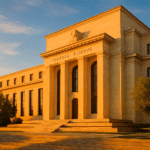Key Takeaways
- Tesla has secured a statewide permit in Texas allowing fully autonomous Robotaxi operations without human safety drivers, effective from 1 September 2025.
- This regulatory milestone marks a critical validation of Tesla’s Full Self-Driving software and supports its strategic pivot towards AI and robotics.
- Market reaction has been optimistic, with TSLA stock rising 3.75% upon news of the permit, and analysts projecting autonomy-related revenue could reach up to 20% of Tesla’s total by 2030.
- Texas’s permissive regulatory environment contrasts with more restrictive states like California, positioning it as a leader in AV testing and deployment.
- Risks remain, including federal scrutiny, technical safety challenges, and competition from both domestic and international autonomous vehicle developers.
Tesla’s push into autonomous ride-hailing has taken a significant step forward with the granting of a statewide permit in Texas, allowing the company to deploy Robotaxis without the need for human safety drivers. This development not only underscores the evolving regulatory landscape for self-driving vehicles but also positions Tesla to accelerate its revenue diversification beyond traditional car sales, potentially reshaping the competitive dynamics in the mobility sector.
The Texas Permit: A Gateway to Scalable Autonomy
Under new Texas legislation effective from 1 September 2025, autonomous vehicle operators must secure permits to run ride-hailing services, with provisions that explicitly enable fully driverless operations. Tesla Robotaxi LLC has obtained such authorisation, marking one of the first instances where a major player can roll out unmanned taxis across the entire state. This comes amid broader efforts by Texas regulators to balance innovation with safety, requiring companies to demonstrate robust technology and compliance before widespread deployment.
The permit’s implications extend far beyond mere regulatory approval. For Tesla, it represents a critical validation of its Full Self-Driving (FSD) software, which has faced scrutiny over incidents and federal investigations. By allowing operations without safety drivers, Texas is effectively betting on Tesla’s AI-driven system to handle real-world complexities, from urban traffic in Austin to highway navigation in rural areas. Reuters reported in June 2025 that Tesla initiated limited Robotaxi testing in Austin, with vehicles initially equipped with safety monitors, but this new permit paves the way for unmonitored expansion.
Analysts at Morgan Stanley have projected that autonomous ride-hailing could contribute up to 20% of Tesla’s revenue by 2030, assuming successful scaling in key markets like Texas. This forecast hinges on Tesla’s ability to leverage its vast data trove from millions of customer-driven miles to refine algorithms, potentially achieving cost efficiencies that undercut human-operated rivals like Uber and Lyft.
Market Reactions and Valuation Shifts
As of 11 August 2025, Tesla’s shares (TSLA) traded at $342.04 on Nasdaq, reflecting a 3.75% intraday gain amid broader market optimism surrounding autonomous tech advancements. This uptick follows a previous close of $329.68, with the stock’s 52-week range spanning $194.67 to $488.54. The price-to-earnings ratio stands at 202.70 for the current year, signalling investor willingness to pay a premium for growth prospects tied to initiatives like Robotaxi.
Comparing this to historical valuations, Tesla’s forward P/E of 105.57 suggests expectations of earnings per share rising to $3.24, driven partly by autonomy-related income streams. Bloomberg data indicates that the permit news aligns with Tesla’s strategic pivot, as the company has redirected resources from traditional EV production to AI and robotics following headquarters relocation to Texas in 2021.
| Metric | Value (as of 11 August 2025) | Change/Note |
|---|---|---|
| Share Price | $342.04 | +3.75% from previous close |
| Market Cap | $1.103 trillion | Reflects autonomy premium |
| EPS (TTM) | $1.68 | Base for growth forecasts |
| 50-Day Average | $320.10 | +6.85% recent change |
Investor sentiment, as gauged by Wall Street ratings averaging a 2.7 (Hold) from sources like Yahoo Finance, remains cautiously optimistic. Bullish voices point to the Texas permit as a catalyst for nationwide expansion, while bears highlight ongoing federal scrutiny from bodies like the National Highway Traffic Safety Administration over past FSD-related incidents.
Broader Implications for the Autonomous Vehicle Industry
Texas’s decision sets a precedent that could influence other states grappling with AV regulations. Unlike California, where Tesla has encountered permitting hurdles as detailed in Politico reports from July 2025, Texas’s pro-business stance—bolstered by Governor Greg Abbott’s signing of the autonomous vehicle bill—offers a more permissive environment. This contrast highlights a fragmented U.S. regulatory patchwork, where states like Texas and Arizona are emerging as testing grounds for driverless tech.
For competitors, the permit intensifies pressure. Waymo, Alphabet’s AV unit, announced Dallas expansion plans for 2026, per Automotive World, but Tesla’s vehicle ownership model—where customers could lend their cars to the Robotaxi fleet—provides a unique edge in scaling supply. CNBC noted in August 2025 that Tesla’s permit allows operations as a transportation network company, akin to rideshare giants, without mandating human oversight.
- Revenue Potential: Analyst models from UBS estimate that a mature Robotaxi network could generate $50 billion annually for Tesla by 2030, assuming 50% U.S. market penetration in ride-hailing.
- Risk Factors: Safety remains paramount; reports of Tesla vehicles disobeying traffic rules during Austin pilots have drawn attention, though no major incidents were recorded.
- Economic Impact: In Texas alone, widespread Robotaxi adoption could disrupt traditional taxi services, creating jobs in tech maintenance while displacing drivers.
Darkly amusing, perhaps, is the irony that a state known for its vast highways and oil heritage is now championing electric, driverless mobility. Yet this shift aligns with Tesla’s vision of autonomy as the cornerstone of future value, potentially eclipsing its core EV business.
Forecasting the Road Ahead
Looking forward, Goldman Sachs analysts forecast Tesla’s Robotaxi service reaching half the U.S. population by end-2025, contingent on replicating Texas’s regulatory successes. This model-based projection assumes accelerated software updates and fleet growth, with EPS potentially jumping 20% year-over-year if autonomy margins exceed 40%.
However, challenges loom. Federal oversight could impose nationwide standards, delaying timelines. Moreover, competition from China’s AV leaders like Baidu might pressure Tesla to innovate faster. Investor sentiment from verified sources, such as Morningstar’s “overvalued” assessment amid high P/E ratios, tempers enthusiasm, urging caution despite the Texas milestone.
In essence, the Texas permit is more than a bureaucratic win—it’s a litmus test for Tesla’s autonomous ambitions. Success here could propel the stock towards its 52-week highs, validating bets on a driverless future. Failure, though, might expose the fragility of over-reliance on unproven tech, reminding markets that even pioneers occasionally hit roadblocks.
References
- Automotive World. (2025). Tesla receives Texas Robotaxi permit under new state laws. Retrieved from https://www.automotiveworld.com/articles/tesla-receives-texas-robotaxi-permit-under-new-state-laws/
- Bloomberg. (2025). Tesla secures Texas rideshare permit for Robotaxi operation. Retrieved from https://www.bloomberg.com/news/articles/2025-08-08/tesla-secures-texas-rideshare-permit-for-robotaxi-operation
- Business Insider. (2025). Tesla Robotaxi Texas permit ridehailing SB2807. Retrieved from https://www.businessinsider.com/tesla-robotaxi-texas-permit-ridehailing-sb2807-2025-8
- CBT News. (2025). Texas clears Tesla for statewide Robotaxi ride-hailing. Retrieved from https://www.cbtnews.com/texas-clears-tesla-for-statewide-robotaxi-ride-hailing/
- CNBC. (2025). Tesla Robotaxi scores permit to run ride-hailing service in Texas. Retrieved from https://www.cnbc.com/2025/08/08/tesla-robotaxi-scores-permit-to-run-ride-hailing-service-in-texas.html
- Drive Tesla Canada. (2025). Tesla secures statewide Texas permit for Robotaxi operations without safety drivers. Retrieved from https://driveteslacanada.ca/news/tesla-secures-statewide-texas-permit-for-robotaxi-operations-without-safety-drivers/
- Electric Vehicles. (2025). Tesla reportedly secures statewide permit for Robotaxis without safety driver in Texas. Retrieved from https://eletric-vehicles.com/tesla/tesla-reportedly-secures-state-wide-permit-for-robotaxis-without-safety-driver-in-texas/
- Live Insurance News. (2025). Tesla’s Texas driverless cars. Retrieved from https://www.liveinsurancenews.com/teslas-texas-driverless-cars/8565097/
- New York Times. (2025). Tesla Robotaxi service in Austin. Retrieved from https://www.nytimes.com/2025/06/22/business/tesla-robotaxi-service-austin.html
- OpenTools.ai. (2025). Tesla shifts gears in Texas with statewide Robotaxi permit. Retrieved from https://opentools.ai/news/tesla-shifts-gears-in-texas-with-statewide-robotaxi-permit
- OpenTools.ai. (2025). Tesla’s Robotaxi revolution: Texas licence unleashes driverless dreams. Retrieved from https://opentools.ai/news/teslas-robotaxi-revolution-texas-license-unleashes-driverless-dreams
- Politico. (2025). Tesla Robotaxi permit problems in California. Retrieved from https://www.politico.com/news/2025/07/30/tesla-robotaxi-permit-problems-california-00486269
- Reuters. (2025). Tesla tiptoes into long-promised Robotaxi service. Retrieved from https://www.reuters.com/business/autos-transportation/tesla-tiptoes-into-long-promised-robotaxi-service-2025-06-22/
- Yahoo Finance. (2025). Tesla secures rideshare licence Texas. Retrieved from https://finance.yahoo.com/news/tesla-secures-rideshare-licence-texas-110501225.html














